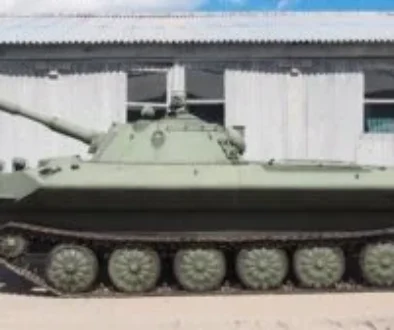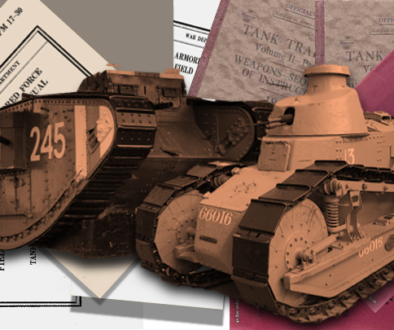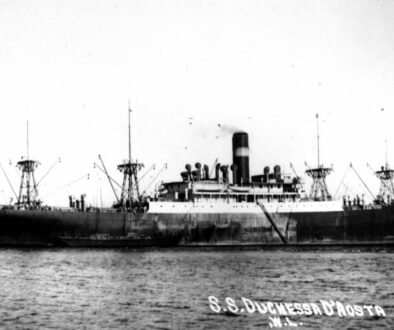Digging In!
A look into WWI Trenches
and the opposing philosophies
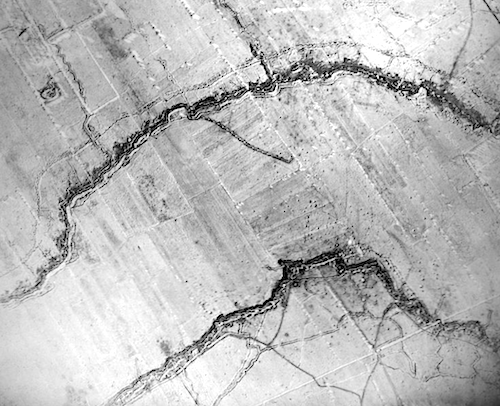
Above: Aerial Photography on the Western Front, 1916. First Army Front: British (upper) and German (lower) front line trenches east of Picantin and le Tilleloy. The German entrenchments shown are ‘Nut’/’Novel’ trenches and the ‘Sugar Loaf’ salient. Credit: IWM
World War I stands as one of the most significant conflicts in modern history, not only for its scale and devastation but also for the innovations in warfare that arose out of necessity. Among the most iconic elements of this war were the trenches—labyrinthine networks dug into the earth that became the defining symbol of the conflict. The trenches were more than just holes in the ground; they were a complex and strategic component of the war, reflecting the philosophies, resource capabilities, and tactical approaches of the opposing armies.
While the first world war is synominous with trenches, it was by no means the first time in history that trench warfare was used, with one of the earliest being seen in the battle of Dara in 530 CE, when the Roman general Belisarius gave orders for his troop to dig defensive trenches and there are many more examples through out history. Perhaps then world war one should be noted for being a ‘modern industrial war’ in which the participants reverted back to ancient tactic.
With that in mind, Lets take a look into the differences between British and German trenches during World War I, and explore the contrasting philosophies behind their construction, the materials and methods used, and the strategic significance of these differences. Which trench type was considered superior and did the opposing armies learn from and adapted each other’s techniques?
The Philosophy Behind Trench Construction
Simply put, the Napoleonic style of manoeuvre warfare, with cavalry dashing from point a to point b, and lines of infantry progressing towards the enemy, died a nasty and short death as a result of both the 8 rounds per second of the German 7.92mm MG 08/15 or the 10 rounds per second of the British .303 Vickers over a range of nearly 3 kilometres and 4 kilometres respectively and the artillery on both sides, that devastated man and horse in the early weeks of the war. It did not take long for either side to dive for cover and dig like moles to try to survive the incessant deadly hail. From that point on, artillery in its many calibres, trench mortars and smaller projectiles would be the main killer on the western front as both sides sort ways to blow holes through opposing trench lines so that infantry could advance.
The trenches of World War I were not a monolithic concept but rather a reflection of the distinct military doctrines, strategic needs, and environmental conditions faced by the armies involved. Understanding the differences in trench construction begins with an examination of the philosophies that guided the British and German approaches.
Lieutenant-General Sir Henry Rawlinson, at the start of the Battle of the Somme – 3 July 1916
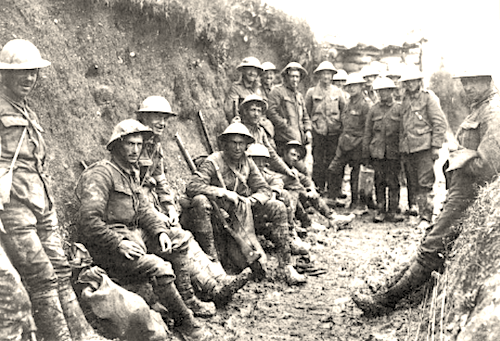
The British Army, along with its Commonwealth allies, initially approached trench warfare with the belief that the conflict would be short-lived. This belief influenced the early design and construction of British trenches, which were often hastily dug and considered temporary structures. British commanders believed that their forces would soon break through the enemy lines, making permanent or highly elaborate trenches unnecessary.
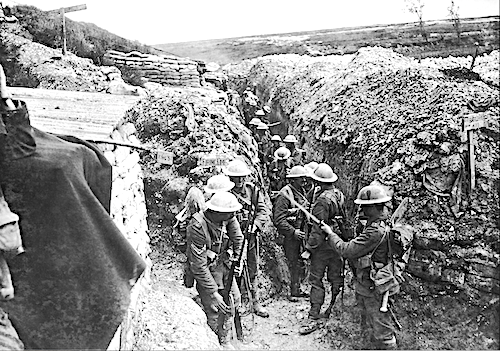
IWM Caption : Battle of Albert : Soldiers of the 1st Battalion, The Lancashire Fusiliers fixing bayonets prior to the attack on Beaumont Hamel. They are wearing ‘fighting order’, with the haversack in place of the pack, and with the rolled groundsheet strapped to the belt below the mess-tin which contained rations. The officer in the foreground (right) is wearing other ranks’ uniform to be less conspicuous. Comment : Trench sign indicates ‘King St‘
As the war dragged on, however, the British Army was forced to adapt. Trenches became more sophisticated and were constructed with greater care, though the initial emphasis on rapid, temporary construction left its mark on British trench design throughout the war.
Key features of British trench philosophy:
Temporary Construction: Early British trenches were often shallow and hastily dug, reflecting the belief in a short conflict.
Offensive Focus: British trenches were designed with offensive operations in mind, emphasizing the ability to launch attacks rather than long-term defense.
Linear Structure: British trench systems tended to be more linear and less elaborate than their German counterparts, with an emphasis on straightforward lines of communication and movement.
German Trench Philosophy
In contrast to the British approach, the German Army viewed trench warfare as a more permanent and strategic aspect of the conflict. German commanders anticipated a protracted war and thus invested significant resources in the construction of deep, well-fortified trenches that could withstand prolonged bombardment and provide a strong defensive position.
German trenches were characterized by their depth, complexity, and use of reinforced materials, reflecting a defensive mindset that prioritized survival and strategic advantage over mobility.
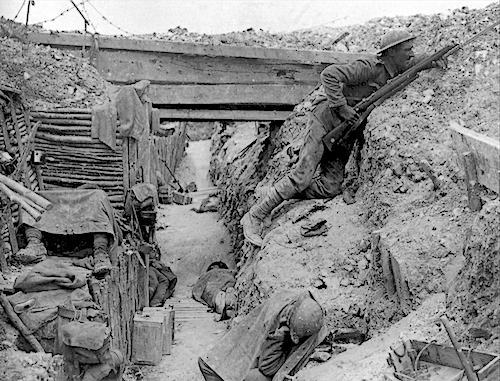
British Soldiers from A Company, 11th Battalion, The Cheshire Regiment occupy a German trench near the Albert-Bapaume road at Ovillers-la-Boisselle, July 1916 during the Battle of the Somme.
Key features of German trench philosophy:
Permanent Construction: German trenches were designed to be permanent fortifications, often dug deep into the ground and reinforced with concrete, timber, and steel.
Defensive Focus: The emphasis was on creating a defensible position that could withstand sustained attacks, with an intricate system of interconnected trenches, bunkers, and strongpoints.
Complexity and Redundancy: German trench systems were more elaborate, with multiple layers of defense, including front-line trenches, support trenches, and reserve trenches, all interconnected by communication trenches.

The philosophical differences between the British and German approaches to trench warfare were reflected in the construction methods and materials used by each side. These differences had a significant impact on the durability, safety, and effectiveness of the trenches, influencing the daily lives of the soldiers who inhabited them.
British Trench Construction
British trenches were often constructed under duress, with soldiers digging in quickly to establish a defensive line in the face of enemy fire. As a result, early British trenches were often shallow, poorly drained, and vulnerable to collapse.

Above: The Loop hole put to use!
An infantryman of the Worcestershire Regiment on the Western Front in 1916, on sentry duty, looking through a loop-hole in a trench at Ovillers, Somme, France. He is wearing the 1908 pattern webbing equipment, a Brodie helmet, and puttees.
British Trench Construction
British trenches were often constructed under duress, with soldiers digging in quickly to establish a defensive line in the face of enemy fire. As a result, early British trenches were often shallow, poorly drained, and vulnerable to collapse.
Materials: The materials used in British trench construction varied depending on availability and location. In many cases, trenches were lined with sandbags, wooden planks, and corrugated iron. Duckboards were laid on the trench floor to provide a stable walking surface and to reduce the risk of trench foot caused by standing in waterlogged trenches.

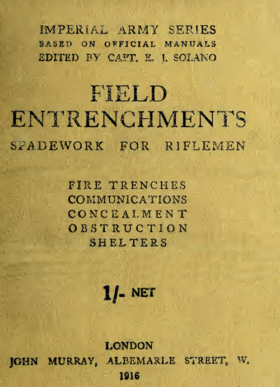
Above: The result of British learning from the Western Front School of hard knocks!
Construction Techniques: British soldiers typically dug their trenches using shovels and picks, working in shifts to create the trench line as quickly as possible. The trenches were often straight and narrow, with minimal zigzagging or curvature, making them more susceptible to enfilade fire.
Reinforcement: Over time, British trenches were reinforced with additional materials, including barbed wire for defence and timber supports to prevent collapse. However, the initial construction often left much to be desired in terms of long-term durability.
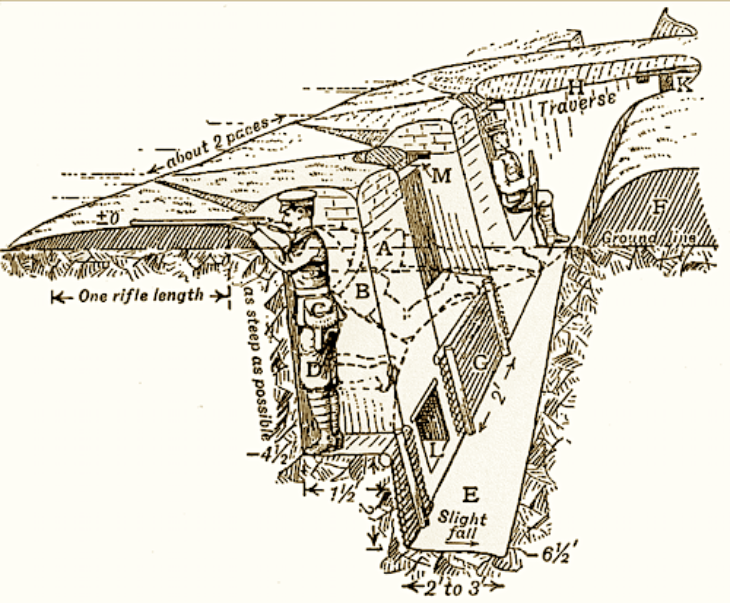
Above: E, passage trench; first a furrow for crawling, finally feet of cover. F, parados (back cover) and surplus earth. G, revetment of firing step. H, traverses of solid ground left at frequent intervals. K, passage round back of traverse, roofed into the parados. L, recesses for ammunition, water, and hand grenades. M, cartridge recesses, for use when firing. – Source: FIELD ENTRENCHMENTS SPADEWORK FOR RIFLEMEN
German trench construction was methodical and reflected a long-term defensive strategy. German trenches were generally deeper, more carefully engineered, and better protected than their British counterparts.
Materials: German trenches were often lined with timber, concrete, and steel. The use of these durable materials reflected the German commitment to creating strong, permanent defensive positions. Concrete bunkers and reinforced dugouts were common features, providing protection against artillery bombardment.

German soldiers of the 11th Reserve Hussar Regiment fighting from a trench, on the Western Front, 1916
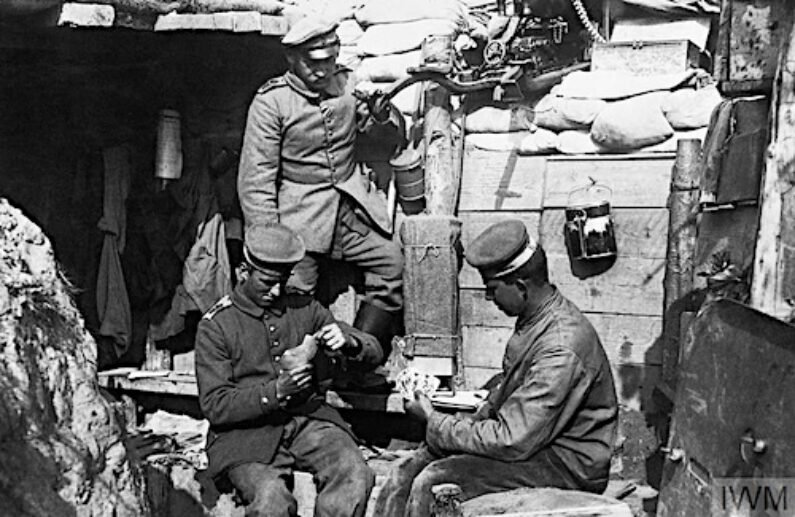
German troops playing cards in the trenches near Ypres. Note a Maxim machine gun ready for use over their heads.
Reinforcement: The German emphasis on defence led to the construction of elaborate bunker systems, underground shelters, and fortified machine gun positions. These features made German trenches formidable obstacles for the Allies to overcome.
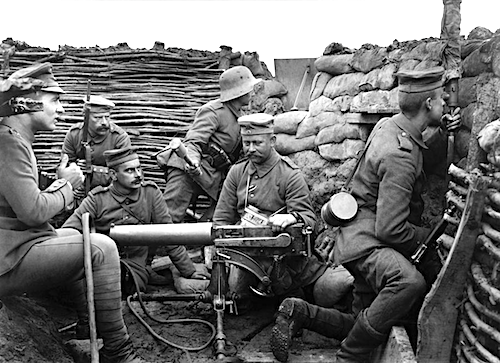
Parapet and Parados: Understanding the Terminology
Two critical features of trench design were the parapet and the parados, both of which played essential roles in the safety and effectiveness of the trenches.
The Parapet
The parapet was the front wall of the trench, facing the enemy. It served as the primary defensive barrier and was often reinforced with sandbags, wooden planks, and other materials to absorb enemy fire and protect the soldiers behind it.
Function: The parapet provided cover for soldiers firing over the top of the trench (known as “going over the top”). It was typically raised above the level of the trench floor, allowing soldiers to fire while remaining partially protected.
Construction: In British trenches, the parapet was often a simple earthwork reinforced with sandbags. In contrast, German parapets were more substantial, often incorporating timber or concrete reinforcements.
Challenges: The parapet was vulnerable to enemy artillery and required constant maintenance to prevent it from collapsing or becoming ineffective.
The Parados
The parados was the rear wall of the trench, facing away from the enemy. Its primary purpose was to protect soldiers from shrapnel and bullets that might overshoot the parapet or ricochet back into the trench.
Function: The parados helped to prevent backblast from artillery strikes and provided additional cover for soldiers within the trench. It also helped to contain any debris or soil displaced by explosions, reducing the risk of burial or injury from collapsing earth.
Construction: Like the parapet, the parados was typically constructed from earth, reinforced with sandbags or wooden planks. In German trenches, the parados was often more heavily fortified, reflecting the overall emphasis on defence.
Challenges: Maintaining the parados was crucial for the safety of the soldiers, especially in areas subject to heavy bombardment. A poorly constructed or damaged parados could leave troops vulnerable to indirect fire.
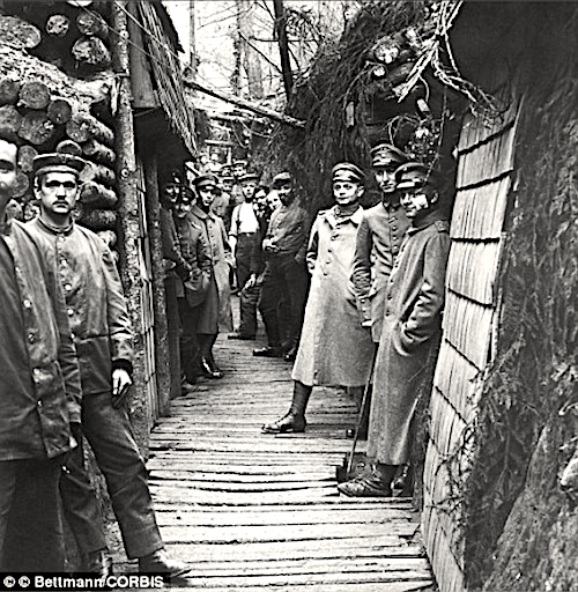
Above: A substantial and comfortable looking trench when compared to those of British design
The question of which trench type—British or German—was better and safer is complex and depends on various factors, including the specific location on the front, the duration of occupation, and the intensity of enemy fire.
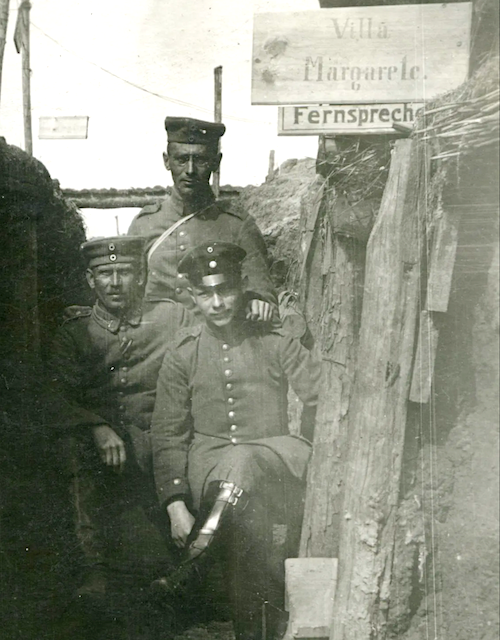
Above : NCO Biernacki, me, NCO Schwabacher, ?? Puppchen of the artillery observers. May 1917
In general, German trenches were considered superior in terms of construction quality, durability, and defensive capability. The deeper, reinforced trenches provided better protection against artillery and small arms fire, while the more elaborate trench systems allowed for greater flexibility in defence and communication. The use of concrete bunkers and underground shelters also gave German troops a significant advantage in terms of protection and comfort.
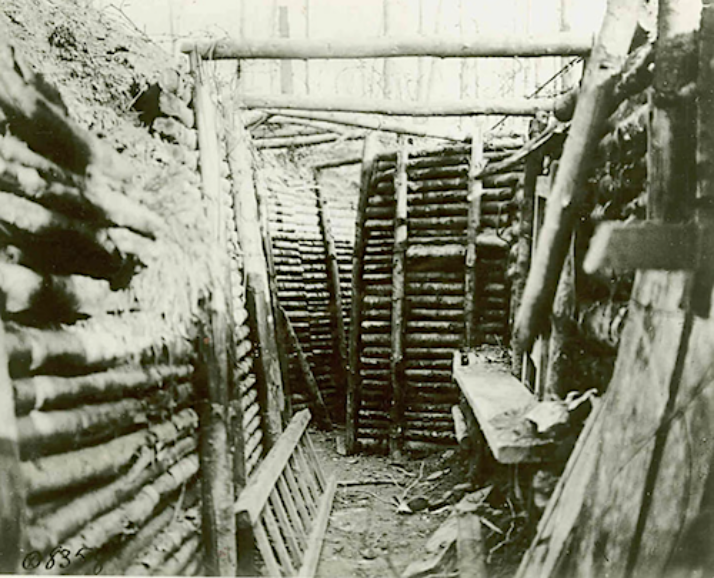
Above: A sophisticated German trench captured in March, 1916, near Baddonviller, France.
British trenches, while initially less durable and more vulnerable, had the advantage of being more adaptable to the demands of offensive operations. The British focus on mobility and the ability to launch attacks meant that their trenches were often closer to the front line and more straightforward in design. This could be an advantage in situations where rapid movement and flexibility were required.
However, the relative lack of depth and reinforcement in British trenches made them more susceptible to enemy fire and less comfortable for long-term occupation. The challenges of maintaining these trenches under constant bombardment also took a significant toll on the morale and health of British soldiers.
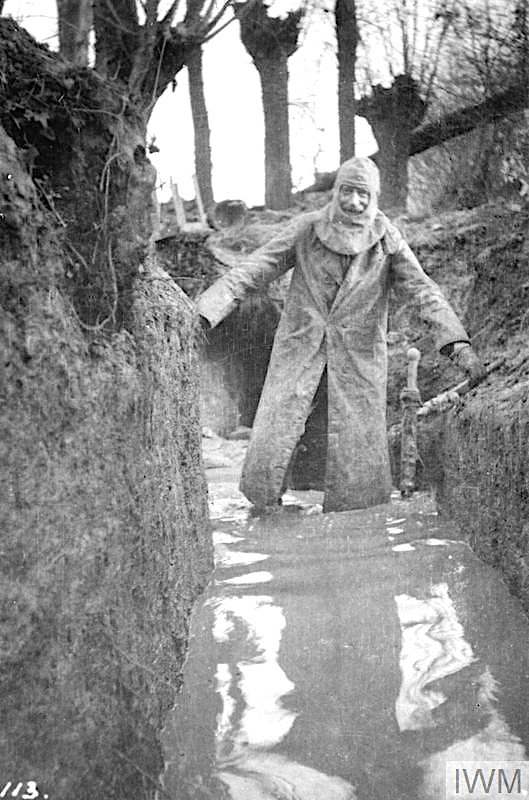
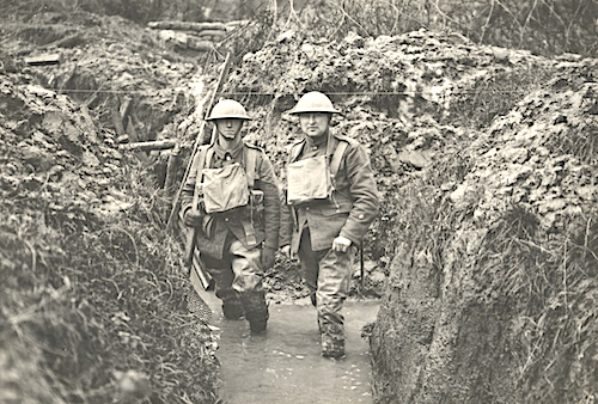
Above: two British soldiers standing in knee deep water in a trench. – “Trenches in front of Serre”. Photograph is possibly by Ernest Brooks, the first official photographer to be appointed by the British military.
Throughout the war, both the British and German armies learned valuable lessons from their experiences in the trenches, and there were instances of each side adapting the other’s techniques.
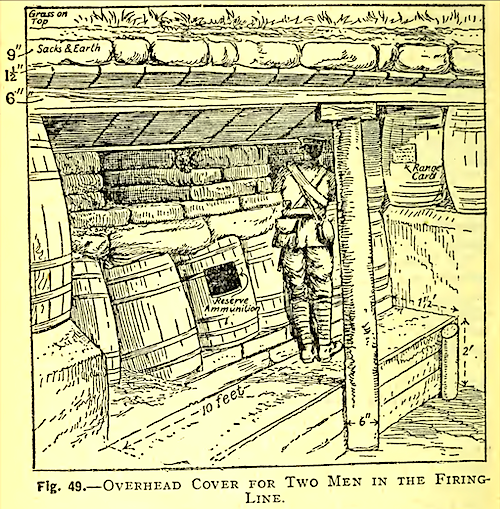
Above & Below : From the British Army’s trench bible: FIELD ENTRENCHMENTS SPADEWORK FOR RIFLEMEN
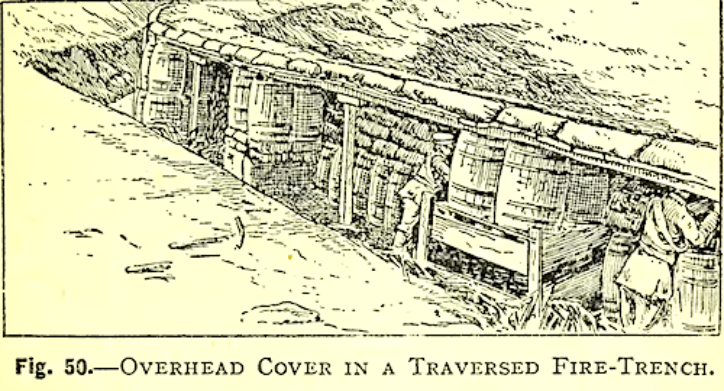
As the war progressed, the British Army began to incorporate more of the defensive features seen in German trenches. This included digging deeper trenches, reinforcing walls with timber and concrete, and constructing more elaborate trench systems with multiple layers of defense. The use of machine gun emplacements, barbed wire, and underground bunkers also became more common as British commanders recognized the value of these features in the German lines.
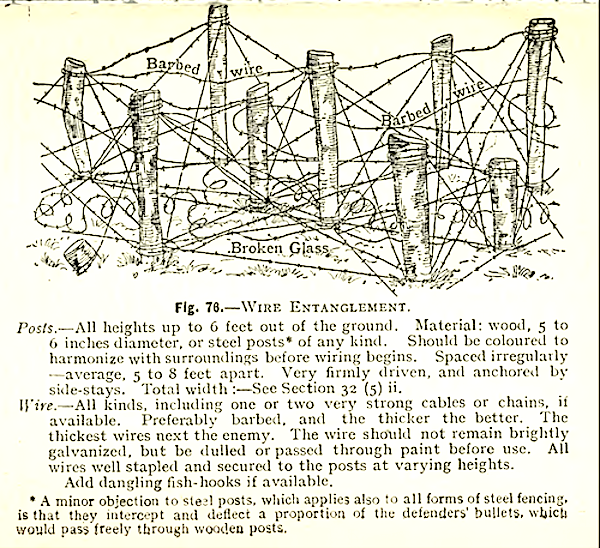
Above : From the British Army’s trench bible: FIELD ENTRENCHMENTS SPADEWORK FOR RIFLEMEN
While the German Army generally maintained its defensive approach, there were instances where they adopted aspects of British trench design, particularly in response to the need for greater mobility. For example, some German trenches were modified to allow for quicker evacuation or to facilitate counterattacks against British advances. The Germans also took note of the British use of artillery and adjusted their trench layouts to better withstand bombardments.
The trench systems of World War I were not uniform but consisted of various types of trenches, each serving a specific purpose within the broader defensive strategy. Understanding these different types is crucial for both historical study and accurate model making.
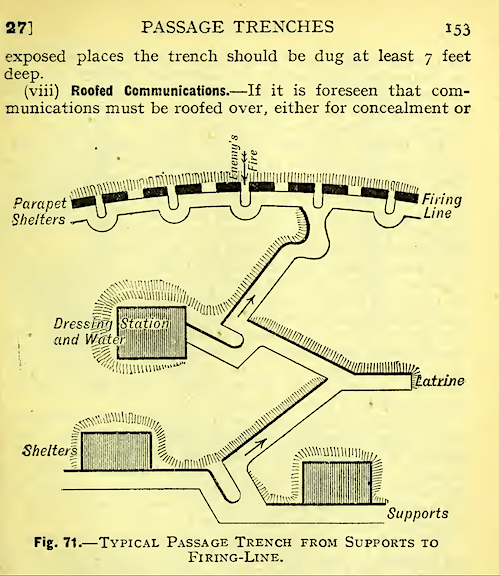
Above : From the British Army’s trench bible: FIELD ENTRENCHMENTS SPADEWORK FOR RIFLEMEN
British: The British front-line trenches were the first line of defense and the launching point for attacks. These trenches were typically shallow and narrow, with minimal reinforcement in the early stages of the war.
German: German front-line trenches were deeper and more heavily fortified, often featuring concrete machine gun emplacements and thick parapets. These trenches were designed to withstand prolonged enemy attacks and provide a strong defensive position.
Support Trenches
British: Support trenches were located a short distance behind the front line and served as a secondary defensive line. They were often connected to the front-line trenches by communication trenches and provided a place for reserve troops to gather.
German: German support trenches were part of a more elaborate system, with multiple layers of trenches providing redundancy and the ability to fall back to a secure position if the front line was breached.
British: Reserve trenches were the last line of defense, located further back from the front lines. These trenches were used to house reserve troops, supplies, and medical facilities.
German: In the German system, reserve trenches were often integrated into a broader defensive network, including underground bunkers and supply depots. These trenches were critical for maintaining the integrity of the defensive line.
Communication Trenches
British: Communication trenches connected the various trench lines and allowed for the movement of troops, supplies, and messages between the front line, support, and reserve trenches. These trenches were usually narrow and less fortified.
German: German communication trenches were more elaborate and often reinforced, reflecting the importance of maintaining secure lines of communication within the trench system.
British: Saps were shallow trenches dug forward from the front line to serve as observation posts or firing positions. Listening posts were small dugouts used to detect enemy movements or tunnelling activity.
German: The German use of saps and listening posts was similar, but they were often more heavily fortified and integrated into the overall trench system.
Aerial trench image: Created and released by the Imperial War Museum on the IWM Non Commercial Licence. Photographs taken, or artworks created, by a member of the forces during their active service duties are covered by Crown Copyright provisions. Faithful reproductions may be reused under that licence, which is considered expired 50 years after their creation.
A ration party of the Royal Irish Rifles: Created and released by the Imperial War Museum on the IWM Non Commercial Licence. Photographs taken, or artworks created, by a member of the forces during their active service duties are covered by Crown Copyright provisions. Faithful reproductions may be reused under that licence, which is considered expired 50 years after their creation.
A German trench occupied by British Soldiers: This work created by the United Kingdom Government is in the public domain.
Battle of Albert : Soldiers of the 1st Battalion: This work created by the United Kingdom Government is in the public domain.
A well concealed and revetted trench, between two-lines of trees. : IWM Non-Commercial Licence
World War I Trench in Cheshire Military Museum: The copyright on this picture is owned by Jeff Buck
German soldiers of the 11th Reserve Hussar Regiment : Public Domain. File:Bundesarchiv Bild 136-B0560, Frankreich, Kavalleristen im Schützengraben.jpg Created: 1916
Colonel Philip R. Robertson, commanding officer of the 1st Battalion – Image: © IWM (Q 51569) IWM Non Commercial Licence,
German troops playing cards in the trenches near Ypres. – Image: © IWM (Q 42252) IWM Non Commercial Licence,
An infantryman of the Worcestershire Regiment on the Western Front in 1916, : John Warwick Brooke – This photograph Q 4100 comes from the collections of the Imperial War Museums.
NCO Biernacki, me, NCO Schwabacher, ?? Puppchen of the artillery observers. May 1917. : https://portraitofwar.com/2019/06/08/wwi-german-trench-life/
